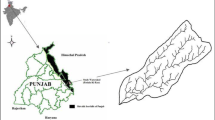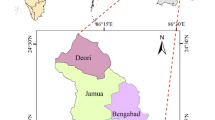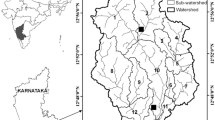Abstract
Land use/land cover changes (LULC) may result in water shortages, flood risk and soil erosion, contributing to the degradation of living situations. Therefore, studying the impacts of LULC changes on water resources is critical to watershed management. This study aims to determine LULC change and its impact on runoff and other hydrological components, including groundwater, water yield, percolation and evapotranspiration in the Upper Prek Thnot watershed from 2006 to 2018, by using SWAT modelling. Results showed that LULC of the Upper Prek Thnot watershed experienced such significant changes during these 13 years. The main modification in the study area was converting forest area into agricultural land, which accounts for 39%. This was followed by increased rubber plantation, built-up area, barren land and water bodies, and decreased wood shrubs. The changes in land use caused an increase in annual average surface runoff (36%), water yield (2%), and a decrease in groundwater (24%), percolation (8%) and evapotranspiration (1%). If the forest area is converted to agricultural land, mainly when the conversion occurs in large numbers, the hydrological elements will be significantly affected. Consequently, due to a noticeable alteration of LULC in the study area, a sound strategic management plan should be applied considerably to ensure ecosystem services sustainability in the watershed area.








Similar content being viewed by others
Data availability
The datasets generated during and/or analysed during the current study are available from the corresponding author on reasonable request.
References
Akoko G, Le TH, Gomi T, Kato T (2021) A review of swat model application in Africa. Water 13:1313. https://doi.org/10.3390/w13091313
American Society of Civil Engineers (ASEC) (1993) Criteria for evaluation of watershed models. J Irrig Drain Eng 119(3):429–442
Ang R, Oeurng C (2018) Simulating streamflow in an ungauged catchment of Tonlesap Lake Basin in Cambodia using Soil and Water Assessment Tool (SWAT) model. Water Science 32(1):89–101. https://doi.org/10.1016/j.wsj.2017.12.002
APFNet (2016) Watershed Characterization of Prek Thnot Watershed. https://www.apfnet.cn/uploads/file/20180311/1520780315809470.pdf
Arnold J, Moraisi DN, Gassman PW, Abbaspour KC, White MJ, Srinivasan R, Santhi C, Harmel RD, van Griensven A, Van Liew MW, Kannan N, Jha MK (2012) SWAT: model use, calibration and validation. Am Soc Agr Biol Eng 55(4):1491–1508
Arubalaji P, Maya K (2019) Effects of land use dynamics on hydrological response of watershed: a case study of Chittar Watershed, Vamanapuram River Basin, Thiruvananthapuram District, Kerala India. Water Conserv Sci Eng 4(1):33–41. https://doi.org/10.1007/s41101-019-00066-5
Astuti IS, Sahoo K, Milewski A, Mishra DR (2019) Impact of land use land cover (LULC) change on surface runoff in an increasingly urbanized tropical watershed. Water Resour Manage 33:4087–4103. https://doi.org/10.1007/s11269-019-02320-w
Babar S, Ramesh H (2015) Streamflow response to land use-land cover change over the Nethravathi River Basin. India. J Hydrol Eng 20:10
Bathurst JC, Iroumé A, Cisneros F, Fallas J, Iturraspe R, Novillo MG, Urciuolo A, de Bièvre B, Borges VG, Coello C, Cisneros P, Gayoso J, Miranda M, Ramírez M (2011) Forest impact on floods due to extreme rainfall and snowmelt in four Latin American environments 1: field data analysis. J Hydrol 400(3–4):281–291. https://doi.org/10.1016/j.jhydrol.2010.11.044
Beven K (2012) Evolution of Rainfall–Runoff Models: Survival of the Fittest? In K. Beven (Ed.), Rainfall-Runoff Modelling: The Primier (Second Edi, pp. 25–50)
Chang M (2013). Characteristic forests. In M. Chang (Ed.), Forest hydrology: an introduction to water and forests, third edition (Third, pp. 123–156)
Chemura A, Rwasoka D, Mutanga O, Dube T, Mushore T (2020) The impact of land-use/land cover changes on water balance of the heterogeneous Buzi sub-catchment, Zimbabwe. Remote Sens Appl Soc Env. https://doi.org/10.1016/j.rsase.2020.100292
Chhinh N, Millington A (2015) Drought monitoring for rice production in cambodia. Climate 3:792–811. https://doi.org/10.3390/cli3040792
Chowdhury R, Flentje P, Bhattacharya G (2010) Geotechnical slope analysis In Geotechnical. Slope Anal. https://doi.org/10.1201/9780203864203
Coffey ME, Workman SR, Taraba JL, Fogle AW (2004) Statistical procedures for evaluating daily and monthly hydrologic model predictions. Transact Am Soc Agricult Eng 47(1):59–68
Das P, Behera MD, Patidar N, Sahoo B, Tripathi P, Behera PR, Srivastava SK, Roy PS (2018) Impact of LULC change on the runoff, base flow and evapotranspiration dynamics in eastern Indian river basins during 1985–2005 using variable infiltration capacity approach. J Earth Syst Sci 127(2):19. https://doi.org/10.1007/s12040-018-0921-8
de Moraes TC, dos Santos VJ, Calijuri ML, Torres FTP (2018) Effects on runoff caused by changes in land cover in a Brazilian southeast basin: evaluation by HEC-HMS and HEC-GEOHMS. Environ Earth Sci 77(6):250. https://doi.org/10.1007/s12665-018-7430-6
Devi GK, Ganasri BP, Dwarakish GS (2015) A review on hydrological models. Aquatic Procedia 4:1001–1007. https://doi.org/10.1016/j.aqpro.2015.02.126
Farinosi F, Arias ME, Lee E, Longo M, Pereira FF, Livino A, Moorcroft PR, Briscoe J (2019) Future climate and land use change impacts on river flows in the Tapajós basin in the Brazilian amazon. Earth’s Future 7:993–1017. https://doi.org/10.1029/2019EF001198
FAO (2003) Digital soil map of the world and derived soil properties.V.3.5., Rome, Italy. FAO land and water digital media series; 1
Gassman PW, Reyes MR, Green CH, Arnold JG (2007) The soil and water assessment tool: historical development, applications, and future research directions. Am Soc Agricult Biol Eng 50(4):1211–1250
Gavit BK, Purohit RC, Bhange HN, Ingle PM (2017) Hydrological modelling using SWAT. Res J Recent Sci 6(11):10–15
Guan X, Zhang J, Elmahdi A, Li X, Liu J, Liu Y, Jin J, Liu Y, Bao Z, Liu C, He R, Wang G (2019) The capacity of the hydrological modeling for water resource assessment under the changing environment in semi-arid river basins in China. Water 11(3):1328
Gupta HV, Sorooshian S, Yapo PO (1999) Status of automatic calibration for hydrologic models: comparison with multilevel expert calibration. J Hydrol Eng 4(2):135–143
Gyamfi C, Ndambuki JM, Salim RW (2016) Hydrological responses to land use/cover changes in the Olifants Basin. South Africa Water 8(12):588. https://doi.org/10.3390/w8120588
He Y, Lin K, Chen X (2013) Effect of land use and climate change on runoff in the Dongjiang basin of south China. Math Probl Eng. https://doi.org/10.1155/2013/471429
Her Y, Frankenberger J, Chaubey I, Srinivasan R (2015) Threshold effects in HRU definition of the soil and water assessment tool. Am Soc Agricult Biol Eng 58(2):367–378
Homdee T, Pongput K, Kanae S (2011) Impacts of land cover changes on hydrologic responses : a case study of chi river basin, Thailand. J Jap Soc Cilvil Eng 67:31–36
Hu S, Fan Y, Zhang T (2020) Assessing the effect of land use change on surface runoff in a rapidly urbanized city: a case study of the central area of Beijing. Land. https://doi.org/10.3390/land9010017
Kateb Z, Bouchelkia H, Benmansour A, Belarbi F (2019) Hydrological modeling using the SWAT model based on two types of data from the watershed of Beni Haroun dam, Algeria. J Water Land Develop 43:76–89. https://doi.org/10.2478/jwld-2019-0065
Khalid C (2018) Hydrological modeling of the Mikkés watershed (Morocco) using ARCSWAT. Sustain Water Res Manag 4:105–115. https://doi.org/10.1007/s40899-017-0145-0
Khalid K, Ali MF, Rahman NFA, Mispan MR, Haron SH, Zulhafizal Othman MFB (2016) Sensitivity analysis in watershed model using SUFI-2 algorithm. Procedia Engineering 162(2016):441–447. https://doi.org/10.1016/j.proeng.2016.11.086
Khokhar A, Yousuf A, Singh M, Sharma V, Sandhu PS, Chary GR (2021) Impact of land configuration and strip-intercropping on runoff, soil loss and crop yields under rainfed conditions in the shivalik foothills of north-west, india. Sustainability (switzerland) 13(11):1–20. https://doi.org/10.3390/su13116282
Khorn N, Ismail MH, Kamarudin N, Nurhidayu S (2020) Land use change using geospatial techniques in upper prek thnot watershed in Cambodia. Pertanika J Sci Technol 28(3):879–892
Kokkonen T, Koivusalo H, Karvonen T, Croke B, Jakeman A (2004) Exploring streamflow response to effective rainfall across event magnitude scale. Hydrol Process 18:1467–1486. https://doi.org/10.1002/hyp.1423
Koomen E, and Stillwell J (2007) Modelling land-use change. In E. Koomen, J. Stillwell, A. Bakema, and H. J. Scholten (Eds.), Modelling land-use change (pp. 1–21)
Lee G, Lee HW, Lee YS, Choi JH, Yang JE, Lim KJ, Kim J (2019) The effect of reduced flow on downstream water systems due to the kumgangsan dam under dry conditions. Water 11:739. https://doi.org/10.3390/w11040739
Leta OT, El-kadi AI, Dulai H (2018) Assessment of SWAT model performance in simulating daily streamflow under rainfall data scarcity in pacific island watersheds. Water 10:1533. https://doi.org/10.3390/w10111533
Li E, Mu X, Zhao G, Gao P, Sun W (2016) Effects of check dams on runoff and sediment load in a semi-arid river basin of the Yellow River. Stoch Env Res Risk Assess 31:1791–1803. https://doi.org/10.1007/s00477-016-1333-4
Li S, Yang H, Lacayo M, Liu J, Lei G (2018) Impacts of land-use and land-cover changes on water yield: a case study in Jing-Jin-Ji. China Sustainability 10:960. https://doi.org/10.3390/su10040960
Mailhot A, Talbot G, Ricard S, Turcotte R, Guinard K (2018) Journal of hydrology : regional studies assessing the potential impacts of dam operation on daily flow at ungauged river reaches. J Hydrol Reg Stud 18:156–167. https://doi.org/10.1016/j.ejrh.2018.06.006
Marhaento H, Booij MJ, Hoekstra AY (2018) Hydrological response to future land-use change and climate change in a tropical catchment. Hydrol Sci J 63(9):1368–1385. https://doi.org/10.1080/02626667.2018.1511054
Martin KL, Hwang T, Vose JM, Coulston JW, Wear DN, Miles B, Band LE (2017) Watershed impacts of climate and land use changes depend on magnitude and land use context. Ecohydrology. https://doi.org/10.1002/eco.1870
Matlhodi B, Kenabatho PK, Parida BP, Maphanyane JG (2019) Evaluating land use and land cover change in the Gaborone dam catchment, Botswana, from 1984–2015 using GIS and remote sensing. Sustainability 11:5174
Mekuriaw T (2019) Evaluating impact of land-use/land-cover change on surface runoff using Arc SWAT model in sore and Geba Watershed, Ethiopia. J Environ Earth Sci 9(10):7–17. https://doi.org/10.7176/jees/9-10-02
Mengistu AG, Van Rensburg LD, Woyessa YE (2019) Journal of Hydrology : Regional Studies Techniques for calibration and validation of SWAT model in data scarce arid and semi-arid catchments in South Africa. J Hydrol Reg Stud. https://doi.org/10.1016/j.ejrh.2019.100621
Mishra AK, Bairagi S, Lourdes M, Mohanty S (2018) Impact of access to capital and abiotic stress on production efficiency: evidence from rice farming in Cambodia. Land Use Policy 79:215–222. https://doi.org/10.1016/j.landusepol.2018.08.016
Moreira LL, Schwamback D, Rigo D (2018) Sensitivity analysis of the soil and water assessment tools (SWAT) model in streamflow modeling in a rural river basin Ambiente and Água: an Interdisciplinary. J Appl Sci. https://doi.org/10.4136/1980-993X
Moriasi DN, Arnold JG, Van Liew MW, Bingner RL, Harmel RD, Veith TL (2007) Model evaluation guidelines for systematic quantification of accuracy in watershed simulations. Am Soc Agricult Biol Eng 50(3):885–900
Msofe NK, Sheng L, Lyimo J (2019) Land use change trends and their driving forces in the kilombero valley floodplain. Southeast Sustain 11:505. https://doi.org/10.3390/su11020505
Mu W, Yu F, Li C, Xie Y, Tian J, Liu J, Zhao N (2015) Effects of rainfall intensity and slope gradient on runoff and soil moisture content on different growing stages of spring maize. Water 7(6):2990–3008. https://doi.org/10.3390/w7062990
Munoth P, Goyal R (2019) Impacts of land use land cover change on runoff and sediment yield of Upper Tapi River Sub-Basin. Intl. J. River Basin Management, India. https://doi.org/10.1080/15715124.2019.1613413
Nash JE, Sutcliffe JV (1970) River flow forecasting through conceptual models part 1: a discussion of principles. J Hydrol 10(1970):282–290
Ndomba P, Mtalo F, Killingtveit A (2008) SWAT model application in a data scarce tropical complex catchment in Tanzania. Phys Chem Earth 33(2008):626–632. https://doi.org/10.1016/j.pce.2008.06.013
Ndulue EL, Mbajiorgu CC, Ugwu SN, Ogwo V, Ogbu KN (2015) Assessment of land use/cover impacts on runoff and sediment yield using hydrologic models: a review. J Ecol Nat Env 7(2):46–55. https://doi.org/10.5897/JENE2014.0482
Nyeko M (2015) Hydrologic modelling of data scarce basin with SWAT model: capabilities and limitations. Water Res Manag 29(1):81–94. https://doi.org/10.1007/s11269-014-0828-3
Reichenbach P, Busca C, Mondini AC, Rossi M (2014) The influence of land use change on landslide susceptibility zonation: the briga catchment test site (Messina, Italy). Environ Manage 54:1372–1384. https://doi.org/10.1007/s00267-014-0357-0
Rodrigues DP, da Silva V, Silva MT, Singh VP, De Souza EP, Braga CC, De Holanda RM, Almeida RSR, Salviano DA, de Sousa F, Braga ACR (2018) Simulation of stream flow and hydrological response to land-cover changes in a tropical river basin. CATENA. https://doi.org/10.1016/j.catena.2017.11.024
Sajikumar N, Remya RS (2015) Impact of land cover and land use change on runoff characteristics. J Environ Manage 161:460–468. https://doi.org/10.1016/j.jenvman.2014.12.041
Sam CS, Goto A, Mizutani M (2007) Distributed Hydrological Modeling of Upper Prek Thnot River Watershed. Transact Jap Soc Irrigat Drain Rural Eng 252:633–642
Sertel E, Imamoglu MZ, Cuceloglu G, Erturk A (2019) Impacts of land cover/use changes on hydrological processes in a rapidly urbanizing mid-latitude water supply catchment. Water 11:1075
Shang X, Jiang X, Jia R (2019) Land use and climate change effects on surface runoff variations in the upper heihe river basin. Water 11:344. https://doi.org/10.3390/w11020344
Singh A (2018) A concise review on introduction to hydrological models global research and development. J Eng 3(10):14–19
Sitterson J, Knightes C, Parmar R, Wolfe K, Muche M, Avant B (2017) An overview of rainfall-runoff model types. US Environmental Protection Agency Report EPA/600/R-153. p 29
Sivakumar B, Singh VP (2012) Hydrologic system complexity and nonlinear dynamic concepts for a catchment classification. Framework 2:4119–4131. https://doi.org/10.5194/hess-16-4119-2012
Stehr A, Debels P, Romero F, Alcayaga H (2008) Hydrological modelling with SWAT under conditions of limited data availability: Evaluation of results from a Chilean case study. Hydrol Sci J 53(3):588–601. https://doi.org/10.1623/hysj.53.3.588
Truong NCQ, Nguyen HQ, Kondoh A (2018) Land use and land cover changes and their effect on the flow regime in the upstream Dong Nai River Basin. Vietnam Water 10:1206. https://doi.org/10.3390/w10091206
Try S, Tanaka S, Tanaka K, Sayama T, Oeurng C, Uk S, Takara K, Hu M, Han D (2020) Comparison of gridded precipitation datasets for rainfall-runoff and inundation modeling in the Mekong River Basin. PLoS ONE. https://doi.org/10.1371/journal.pone.0226814
Tsujimoto K, Ohta T, Aida K, Tamakawa K, Im MS (2018) Diurnal pattern of rainfall in Cambodia: its regional characteristics and local circulation. Prog Earth Planet Sci 5:39
Vadrevu K, Heinimann A, Gutman G, Justice C (2019) Remote sensing of land use/cover changes in south and southeast Asian countries. Int J Dig Earth 12(10):1099–1192. https://doi.org/10.1080/17538947.2019.1654274
Wang K, Zhang Q, Chen YD, Singh VP, Wang K, Zhang Q, Chen YD, Effects VPS, River E (2015) Effects of land-use/cover change on hydrological processes using a GIS/RS-based integrated hydrological model: case study of the east river, China effects of land-use/cover change on hydrological processes using a GIS/RS-based integrated hydrolo. Hydrol Sci J 60(10):1724–1738. https://doi.org/10.1080/02626667.2014.949723
Wei, X., Li, Q., Zhang, M., Liu, W., and Fan, H. (2016). Forest Cover Changes and Hydrology in Large Watersheds. In D. M. Amatya, T. M. Williams, L. Bren, and C. de Jong (Eds.), Forest Hydrology-processes, management and assessment (pp. 180–191)
Zhang X, Yu X, Wu S, Liu H (2007) Effects of forest vegetation on runoff and sediment transport of watershed in Loess area, west China. Frontiers of Forestry in China 2:163–168. https://doi.org/10.1007/s11461-007-0026-z
Zhang L, Li J, Li X, Zhang J, Zhu H (2016) Rainfall-induced soil slope failure: stability analysis and probabilistic assessment. Rainfall-Ind Soil Slope Fail. https://doi.org/10.1201/b20116
Acknowledgements
The authors are thankful to the Southeast Asian Regional Center for Graduate Study and Research in Agriculture (SEARCA) under the Graduate Scholarship Institutional Development (GSID) Program.
Author information
Authors and Affiliations
Corresponding author
Ethics declarations
Conflict of interest
The authors have not disclosed any competing interests.
Additional information
Publisher's Note
Springer Nature remains neutral with regard to jurisdictional claims in published maps and institutional affiliations.
Rights and permissions
Springer Nature or its licensor holds exclusive rights to this article under a publishing agreement with the author(s) or other rightsholder(s); author self-archiving of the accepted manuscript version of this article is solely governed by the terms of such publishing agreement and applicable law.
About this article
Cite this article
Khorn, N., Ismail, M.H., Nurhidayu, S. et al. Land use/land cover changes and its impact on runoff using SWAT model in the upper Prek Thnot watershed in Cambodia. Environ Earth Sci 81, 466 (2022). https://doi.org/10.1007/s12665-022-10583-7
Received:
Accepted:
Published:
DOI: https://doi.org/10.1007/s12665-022-10583-7




